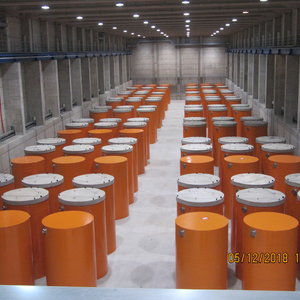Spent Nuclear Fuel Storage

From the beginning of INPP operation, spent nuclear fuel (SNF) has been stored in special storage pools constructed near the reactor premises. There are currently about 22,000 fuel assemblies at INPP, this is 2,500 tons of SNF, of which 16,000 fuel assemblies or 1,800 tons of SNF are stored in the reactor and storage pools.
This is a temporary method of storage. For this reason, there had to be dealt with the organization of SNF storage in the future. Due to the absence of the possibility of SNF transport for recycling, the ways for long-term storage of SNF at on-site conditions had to be looked for.
It was decided to store SNF in a dry way using first CASTOR RBMK-1500 and later CONSTOR RBMK-1500 casks at the special INNP storage facility. The dry type storage facility for SNF was constructed where currently it is possible to store up to 120 casks. The storage facility was constructed at INPP site 1 kilometer away from the power units.
CASTOR cask is manufactured of metal, CONSTOR cask – reinforced concrete. Both types of casks are manufactured by GNB (Germany). The walls of metallic casks are manufactured of specific composition of thick carbon steel. The thick walls not only make the casks stronger but also act as a biological shielding against ionizing radiation. Reinforced concrete casks are somewhat different. They consist of two thin-walled cylinders of special steel the gap between which is filled with concrete.
Strict requirements are set to the casks. The most important is that there must be ensured that no nuclear fission chain reaction will occur in the cask. Other important requirements are heat removal, radiation safety and mechanical resistance. The thickness of the cask walls must be such that the radiation dose rate on the cask surface does not exceed permissible limits and poses no danger to the service personnel, population, and the environment. Furthermore, the casks must not be damaged as a result of explosion, fire, flood, earthquakes, and even light planes drop. The casks of this kind are suitable both for storing SNF and transporting it.
In March 1999, tests were commenced on transferring SNF from the storage pools to the on-site storage facility of dry type. On May 12, 1999, the first steel CASTOR cask with SNF was taken to the storage facility.
After being stored in the storage pools for several years, SNF is retrieved from there, loaded into steel or reinforced concrete casks and taken to a storage site nearby. An empty CASTOR cask weighs 58 tons and with SNF about 72 tons. At the storage site the casks with SNF will be stored for at least 50 years.
The cases of CASTOR RBMK-1500 and CONSTOR RBMK-1500 casks have leaktight lids system. The design of casks ensures safe and reliable storage under the normal conditions as well as in case of potential emergencies.
The existing INPP on-site dry type SNF storage facility has been totally filled. The left SNF is still stored in the Unit 2 reactor and storage pools of both units until the new interim SNF storage facility (ISFSF, decommissioning project B1) will be constructed. Therefore it is necessary to ensure the highest requirements of reactor's operation safety and SNF management.
The new Interim Spent Fuel Storage Facility (ISFSF) will be commissioned nearby the INPP in early 2017. In the storage facility SNF will be stored in the new type reinforced concrete casks CONSTOR RBMK-1500/M2 each of which is 4,5 m high, 2,7 m in diameter and weighs 118 tons loaded with fuel. The site of the new ISFSF will cover 5.93 hectares of the area. The total storage capacity will be about 17,000 fuel assemblies (about 190 casks).
This will ensure safe and reliable way of storage of SNF in accordance with the requirements of the Republic of Lithuania, the EU standards and IAEA recommendations. The operation of storage facility will continue for 50 years.
It is expected to construct deep-earth repository for such type of waste after the termination of ISFSF operation period but its location and technical specifications will be considered in the future. Consequently, the issue of SNF management after 50 years remains currently unresolved.

